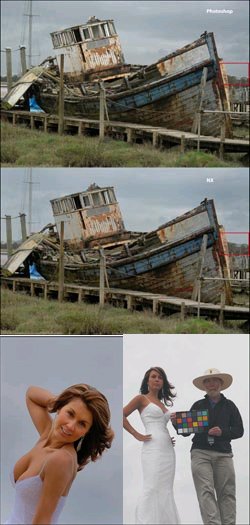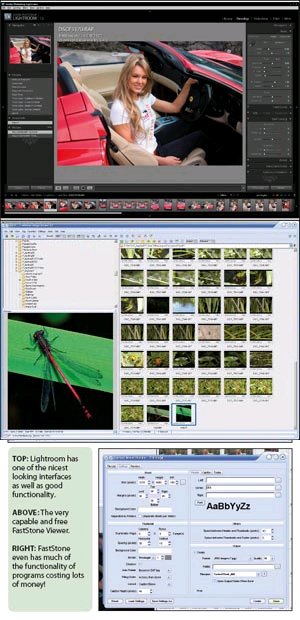articles/Digital/captureraw-page3
Image Capture for RAW - part 3 of 1 2 3
by Mike McNamee Published

The speed benefits of processing skies in this manner is significant. In the example of the derelict boat shown, we darkened the sky in Capture NX in 2m 16s, using a control point which we then duplicated three times to refine the adjustment area to just the sky. In Photoshop we opened the RAW file and processed it for the background tone, then duplicated the image and closed the original. We then reprocessed the RAW file with a darker sky and shift dragged it onto the duplicate. Then we made a mask to leave only the dark sky showing using the Magic Wand and Quick Mask. This Layer Mask was then blurred slightly to refine the edges. This took 4m 16s but remember that we have performed this exercise in seminars on dozens of occasions. The U-Point technology creates a more refined transition between the sky and the boat. Note that the blue tarpaulin was left overbright. This could be darkened by adding another control point in Capture NX, in a matter of seconds, far quicker than adjusting the Photoshop Mask. For a task such as this then NX wins hands down and does a better job in the short term. While it would have been possible to spend longer on the Photoshop approach, the difficult transition between the sky and the trees is always problematic but was handled with complete ease by NX - this was the really impressive part of the tests we carried out and would justify the cost of NX on its own!
There is the potential option to exploit the power of Capture NX to create a mask for sky replacement rather than colour adjustment. We are grateful to SWPP member Paul Atkins for suggesting this method during a demonstration by American Tony Corbell on his recent SWPP/BPPA, UK tour. Talking over the possibilities during a coffee break we pondered if it would be possible to utilise the U-Point method to drive the sky (for example) to pure white and then use this to create a mask for a sky change. The technique was moderately successful and certainly worth some development - we await feedback from our clever readers!

images - Tom Lee
RAW Capture and Viewing Options
It is difficult to test Aperture in our all-PC environment. Visiting the various web forums is a waste of time, riddled as they are with fights between diametrically opposed parties unwilling to give an inch to their rivals! None of them seems to possess a stop-watch - it's not rocket science guys, you process 10 images against the clock and move the decimal place one slot to get the time per image!
The summary from our research is that Aperture costs more (£219 against £156) and is slower in all but webpage building. Some claim Lightroom to be twice as fast at processing images. Lightroom also has the ability to dual process, working on images while you get on with other things, Aperture does not apparently do this. The small number of 'wedding' users we spoke to seemed to be reluctant to shift from Bridge, using the processing part of the workflow as a step towards refining images in other ways.
Other Software
The iView media pro software kept cropping up during these conversations especially when a quick look at images was needed. In our experience FastStoneImage Viewer is an excellent (and free!) image viewer, which handles RAW files as well as all the usual suspects. The 3.4MB file took a couple of minutes to download, about 20 seconds to install whereupon we were able to view 107 images in13s. Loading individual files for viewing took 2.9s and to process a RAW file at full size took 4.9s. This takes some beating for a piece of free software. The software has contact sheet builders, red-eye removal, sharpening, colour correction, slide-show builders, pdfmakers and a host of other features. It does not obey sidecar metadata and displays ARGB files as sRGB, ie lower saturation but this is about the only flaw we can detect.
RAWShooter has been woven into the Adobe products, Phase 1 seems hell-bent on annoying its user base, with time-based use charges, when all around them are providing free upgrades or freely available software. ACDC remains quite a fast way of examining images. For printing, Qimage remains top of many experienced user's lists.
Where does this leave us?
Well for starters, if you have Bridge and like it, move no further. Lightroom is good as a standalone if you have no intention of going to Photoshop (Aperture perhaps for the Mac-monkeys). Capture NX is useful for its U Point technology. For simple viewing you should try FastStone before all else as it is free. For colour precision, Bridge and Adobe RAW create the most accurate renditions when used skillfully. For recovering over-exposed shots the cameramaker's software and noise reduction might give you an edge (it certainly does with Fuji FinePixViewer). The chances are that you will end up with a suite of software which you mix and match, depending on your workflow.
Please Note:
There is more than one page for this Article.
You are currently on page 3 Contact Mike McNamee
1st Published
last update 09/12/2022 14:52:15
More Digital Articles
There are 18 days to get ready for The Society of Photographers Convention and Trade Show at The Novotel London West, Hammersmith ...
which starts on Wednesday 14th January 2026




